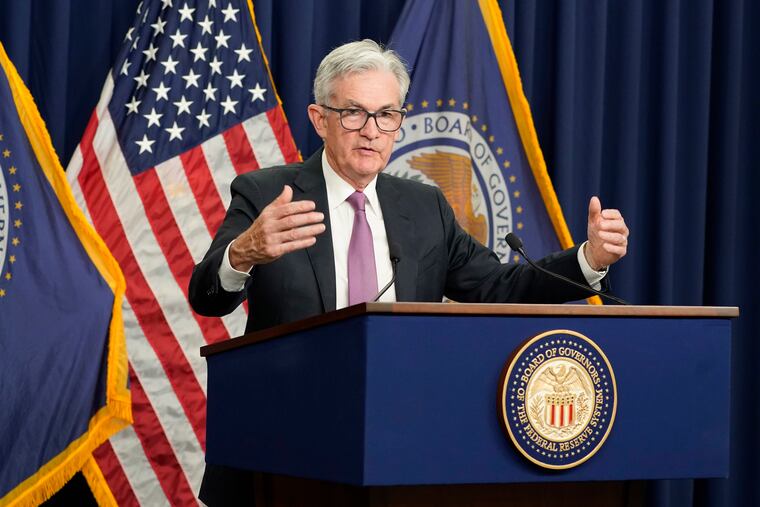What it means for you now that the Fed’s raised interest rates — again
The Fed bumped up rates on Wednesday. What does it mean for student loans, credit card bills and mortgages?

The cost of borrowing money is going up even more.
That’s because the Federal Reserve, America’s central bank, on Wednesday raised its key interest rate three-quarters of a point.
The central bank’s rate increase follows a March hike of 0.25 percentage points, and a June increase of 0.75 percentage points. The central bank wants to tame the highest inflation rates the United States has seen in 40 years.
What does it mean when the Fed raises interest rates?
The Federal Reserve sets the interest rates that banks charge each other for overnight loans to meet reserve requirements.
This rate, the benchmark federal-funds rate, influences the interest that financial institutions charge consumers to make purchases such as homes and cars, and finance student loans and credit cards. When the Fed raises its federal-funds rate, commercial borrowing rates follow in the same direction.
When the pandemic began in March 2020, the range for this short-term, overnight interbank rate was as low as 0.0%-0.25%.
The Fed on Wednesday added another three-quarters of a percentage point, to a range of 2.25% to 2.50%, as part of scheduled hikes this year.
The Fed’s key interest rate has been a powerful tool in setting monetary policy. Lowering the rate revs up the economy by making it cheaper to borrow money, while raising the rates puts on the brakes.
What factors into the decision?
How high might rates go? It depends on the economy.
“We could see another three or four rate hikes, anywhere from 0.75% to 1.00% by the end of this year,” said James Barnes, director of fixed income for Bryn Mawr Trust, a division of WSFS Bank.
Higher energy prices due to Russia’s invasion of Ukraine lifted prices at the gas pump. In many states, gas prices rose above $5 per gallon, with the price of diesel often above $6 per gallon. That contributed to consumer inflation, which Americans feel painfully in their wallets.
But higher interest rates are meant to cool spending, Barnes said, so now the Fed will wait and see.
Come September, when the Fed meets next, “we need to see inflation peaking and rolling over. So if July and August inflation readings peak and then come down, the Fed would look at that as data going in the right direction for their purposes,” Barnes said. Lower inflation readings this year could also remove the need for additional rate hikes.
Credit card rates and auto loan interest rates are already high, said Lara Rhame, chief U.S. economist with FS Investments in Philadelphia. “Those won’t move as much as loans grounded in the banking system, such as construction and small-business loans, 18-month and two-year loans,” Rhame said. “Those will move up quickly with the federal-funds rate hike.”
Why now?
Worries about inflation and war in Ukraine have displaced concerns about the pandemic.
The Fed raised rates earlier this year to slow soaring inflation. Although higher interest rates can put the brakes on the economy, Fed chair Jerome Powell has said that solid hiring and wages show America is strong enough to withstand the hikes.
Overall, the Fed went into this meeting with “no signs of a recession, substantially higher-than-desired inflation and no signs that it is slowing, a moderating construction sector, and continued strength in labor markets,” wrote Cumberland Advisors bond portfolio manager David Kotok in a note to clients Monday.
U.S. inflation jumped 9.1%, over the 12 months ending in June, according to the Labor Department.
But inflation is a global phenomenon right now — and the U.S. has actually fared better than other countries. In June, consumer prices increased 9.6% across the E.U. in the same period.
What does this mean for my student loans?
Most federal student loans have fixed interest rates, and a fixed-rate loan wouldn’t change, so your interest rate and payment remain the same.
“If you have a federal loan, this doesn’t affect you. Your rate is fixed,” said student loan expert Anna Helhoski.
Private student loans, however, often have variable rates, and “this rate hike affects borrowers in the private market immediately,” said Helhoski, who works for the NerdWallet personal finance website and app.
The rate hike adds an additional 0.75% percentage points to your private student loan interest. A private student loan lender determines interest rates based on credit history, the school you attend, and your course of study, according to the Consumer Financial Protection Bureau.
Your lender must tell you your rates. If you already have a loan, log in to your student loan account on your lender’s website, or call your servicer to find interest rate information.
For federal student loans, payments are paused and interest is currently frozen at 0% through Aug. 31. But you can always check your current interest rate on the Department of Education’s website: studentaid.gov/understand-aid/types/loans/interest-rates.
A total of 26.6 million people are expected to resume student loan payments after Aug. 31, following the pause on payments during the pandemic that took effect in March 2020. Though the Biden administration may decide to extend the pause yet again.
How much will mortgages cost now?
Mortgage interest rates aren’t directly tied to the federal-funds rate, but nonetheless these have moved up, too.
A 30-year fixed-rate mortgage averaged 5.54% the week ended July 21, up from 4.16% in the week ending March 17, according to Freddie Mac data on the St. Louis Federal Reserve website.
Home prices were up 17% year-over-year in 2021. But higher interest rates are helping to cool the froth. Overall, existing-home sales have dropped for five straight months, according to the Wall Street Journal.